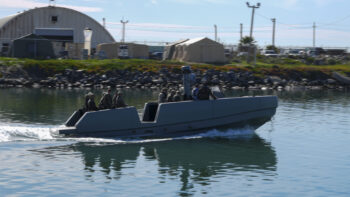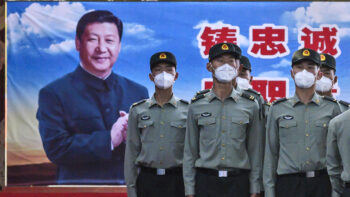
Deputy Secretary of Defense Kathleen H. Hicks is walks with Director of the Defense Innovation Unit Doug Beck during a visit to the Defense Innovation Unit, Mountain View, California, Dec. 12, 2023. (DoD photo by U.S. Navy Petty Officer 1st Class Alexander Kubitza)
WASHINGTON — As the Defense Innovation Unit evolves into its next chapter, dubbed DIU “3.0,” the agency will begin to take on more “real risk” as it figures out how to more effectively adopt commercial technologies at speed and scale, according to its new strategy.
“The imperative for DIU 3.0 is clear,” according to the strategy, which was released publicly today. “Against a backdrop of international challenges and with the world’s most capable technology sector, we can and must do more to identify and adopt impactful commercial technologies at speed and scale.”
The strategy mirrors public comments made over the past year from DIU Director Doug Beck on the focus the innovation hub is taking as it evolves to its next phase. Founded in 2015 by then-Secretary of Defense Ash Carter, DIU was envisioned as a go-between for the tech community and the Pentagon. At the time, DIU was designated to report up to Carter but was later downgraded to report to the undersecretary of defense for research and engineering.
When Beck came on board last May, Secretary of Defense Lloyd Austin redesignated DIU to report directly up to him. In an interview with Breaking Defense last September, Beck said that the agency was going through a “pretty significant shift” where it’s becoming more embedded across the department.
According to the strategy, DIU 1.0 was focused on connecting DoD with the commercial technology sector and DIU 2.0 was focused on proving out the innovation hub’s model for delivering commercial capabilities to the battlefield.
“The challenge now is to take the capabilities developed during DIU 2.0 and apply them with the focus, scale, and speed necessary to deliver the strategic effect required,” according to the strategy. “This is what DIU 3.0 is all about.”
Today’s strategy details how, with more support, DIU has evolved since its inception, though DoD still “will not be able to reap the benefits of many of these actions until the 2030s and beyond.” The strategy further says that DoD needs to move quicker to adopt “disruptive technologies from nontraditional, commercial sources with the volume and velocity necessary to deter potential adversaries and ensure victory in future conflicts,” specifically calling out China and Russia.
As part of the change, DoD needs to work closer with its partners inside and outside of the government, the strategy says, which will require taking on “bureaucratic, financial, institutional, and reputational risk in doing so.”
“But it is far better for us to take those kind of risks — all of which can be mitigated, managed, or overcome — now than it is for us to take the risk of inaction,” according to the strategy. “Doing that would merely continue the unforgivable pattern of transferring that risk to the future, converting it to real risk to the warfighter, to the soldiers, sailors, airmen, guardians, and marines who will be on the front lines in a future war.”
Eight lines of effort are outlined in the new strategy, beginning with focusing on the most critical capability gaps faced by warfighters. As part of this effort, DIU aims to “continue to deepen its embedded support” to US European Command (EUCOM), US Indo-Pacific Command and across the force. Last August, Adm. John Aquilino, head of INDOPACOM, announced the Joint Mission Accelerator Directorate that would include an embed from DIU focused on the Joint Fires Network and other areas.
The strategy says another embed was sent to EUCOM’s Security Assistance Group-Ukraine and more embeds are planned across the combatant commands that “will both help shape demand for technology and ensure that innovation efforts are unwaveringly focused on meeting it.”
Another line of effort outlined in DIU’s strategy includes partnering more closely with the military services, or DoD’s “engines of scale,” the joint staff and office of the secretary of defense to scale successful prototypes. As part of deepening collaboration inside of DoD, DIU is a member of Deputy Secretary of Defense Kathleen Hicks’s Deputy’s Innovation Steering Group and chairs its supporting Defense Innovation Working Group.
Along with his role on DISG, Beck is also chairing the Defense Innovation Working Group, and both groups “serve as the governance” for the Replicator initiative which aims to field thousands of attritable autonomous systems in 18 to 24 months in an effort to counter China’s military mass.
Replicator “is a moonshot — and will not be easy. But it is a perfect example of what we must do — leverage emerging technology to deliver operational capability, now, and work across the Department to deliver scale, fast,” according to the strategy.
Other lines of effort include synergizing DoD’s “innovation entities,” like the Chief Digital and Artificial Intelligence Office; elevating partnerships with the commercial sector; deepening collaboration with allies and partners; building momentum for speed and scale; fostering talent and providing Austin and Hicks “with world class dual fluency advice.”





















